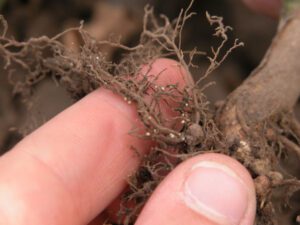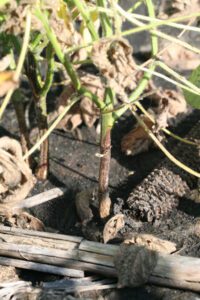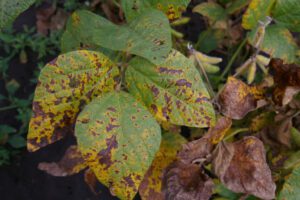By Louis Sutton
AgVenture Regional Product Manager (West) & Agronomy Lead
Farmers need to be aware of several diseases that can affect corn and soybean crops during the spring growing season. The following are some of the most common corn and soybean diseases to watch for during this time.
Corn Diseases
Gray Leaf Spot: a fungal disease that causes lesions on leaves and can reduce yield potential. Symptoms first appear on lower leaves about 2-3 weeks before tassel. The leaf lesions are long, up to two inches, narrow, rectangular, and light tan in color. Later, the lesions can turn gray. The lesions are typically delimited by leaf veins, but they can join together to kill entire the entire leaf. The fungus Cercospora zeae-maydis survives in corn residue, making the disease most severe in continuous corn conditions.
Common Rust: a fungal disease that causes small reddish-brown pustules on leaves and can also reduce yield potential. Caused by the fungus Puccinia sorghi, common rust pustules will begin appearing in late June. Chlorotic flecks on the leaf surface are the earliest symptoms. The fungus overwinters in sub-tropical and tropical environments, traveling to the Midwest by wind. Rust development is favored by high humidity with night temperatures of 65-70°F and moderate daytime temperatures.
Northern Corn Leaf Blight: a fungal disease that causes cigar-shaped lesions on leaves and can lead to yield losses. Symptoms usually appear first on the lower leaves. NCLB is caused by the fungus Setosphaeria turcica and overwinters in corn residue. Spores are dispersed by wind and splashing water. Disease development is favored by extended periods (>6 hours) of leaf wetness (rain or dew) and moderate temperatures (64-81°F).
Soybean Diseases
Soybean cyst nematode: a parasitic roundworm that attacks the roots of soybean plants, causing stunting and reduced yields. Noticeable symptoms of SCN include stunting, slow or no canopy closure, and chlorotic foliage. Infected plants have poorly developed root systems and may have reduced numbers of nitrogen-fixing nodules. Signs of SCN include white females most readily seen in the field starting about six weeks after crop emergence. Dig roots and carefully remove soil to see the females. SCN (Heterodera glycines) survives in the soil as eggs in dead females, surviving several years after a soybean crop has been planted in the field. SCN develops in the same conditions that favor soybean growth. High soil pH (7.0 to 8.0) may be used to predict where SCN is more problematic. Talk to your AgVenture Yield Specialist about the best times to test soil for presence of SCN. Seed treatment packages for SCN-prone fields are available through your local AgVenture Independent Seed Company.
Phytophthora root and stem rot: a fungal disease that causes wilting and yellowing of leaves, as well as stem and root rot. Phytophthora sojae can infect soybeans at any growth stage from seed to maturity. Early season symptoms include seed rot and pre- and postemergence damping off. PRR is more severe in no-till fields, poorly drained soils, or low-lying areas that are prone to flooding. The oomycete pathogen survives on crop residue or in the soil as oospores. When soil temperatures reach 60°F and soil is saturated, oospores germinate and produce swimming spores, called zoospores. Warm, saturated soil, especially shortly after planting, are conducive to disease. Infection occurs via the roots, and from there the pathogen colonizes the roots and stems. Talk to your AgVenture Yield Specialist about soybean varieties with defense against PRR and make sure your seed is protected with a premium seed treatment package.
Brown spot: a fungal disease that causes small, brown lesions on leaves and can reduce yields. Septoria brown spot is caused by the fungus Septoria glycines. This disease develops shortly after planting and remains present throughout the growing season. Mild symptoms occur during the vegetative growth stages, with purple legions on the unifoliate leaves showing up on young infected plants. Symptoms will progress upward from the lower leaves during grain fill, when infected leaves quickly turn yellow and drop. Septoria glycines survives on infected leaf and stem residue and the disease develops during hot, dry weather, supported by warm and wet conditions. Foliar fungicides during R3 to R5 may slow the rate of disease development from lower to upper canopy.
Summary
To prevent or control these diseases, farmers should practice good crop management techniques, including crop rotation, selecting resistant seed varieties, scouting regularly for signs of disease, and applying fungicides as needed. It’s also important to maintain good soil health and avoid practices that can promote disease development, such as planting in wet soils or using contaminated equipment.





